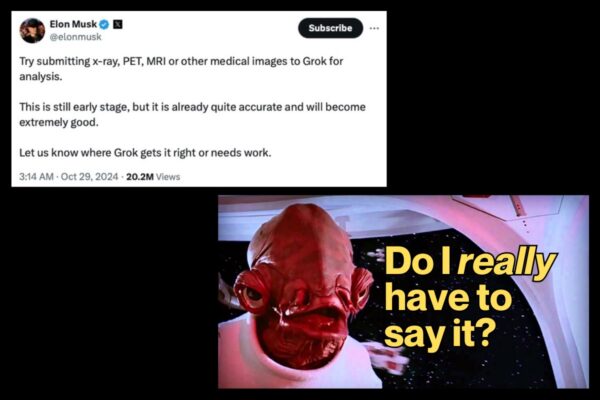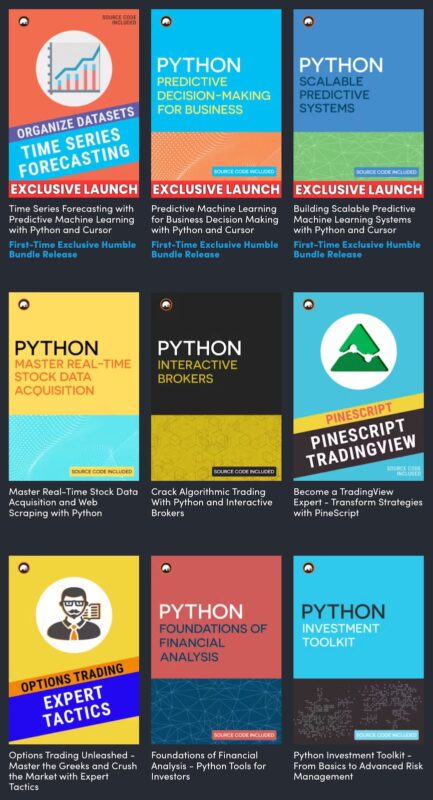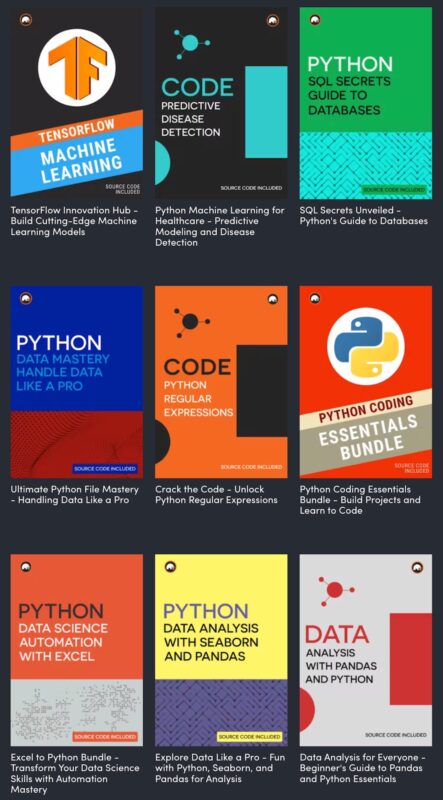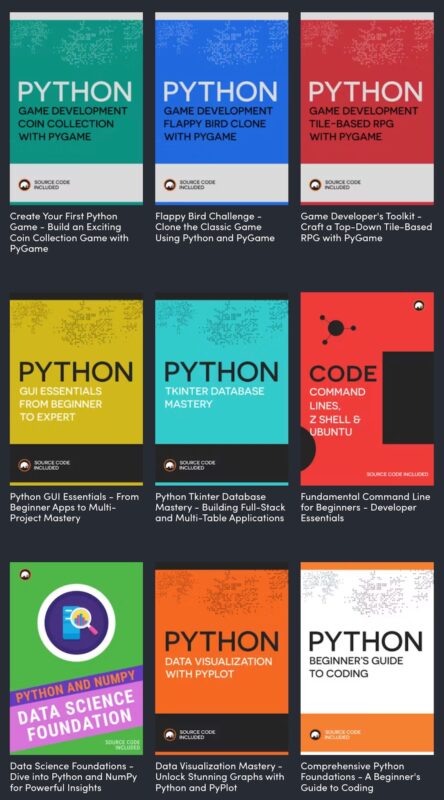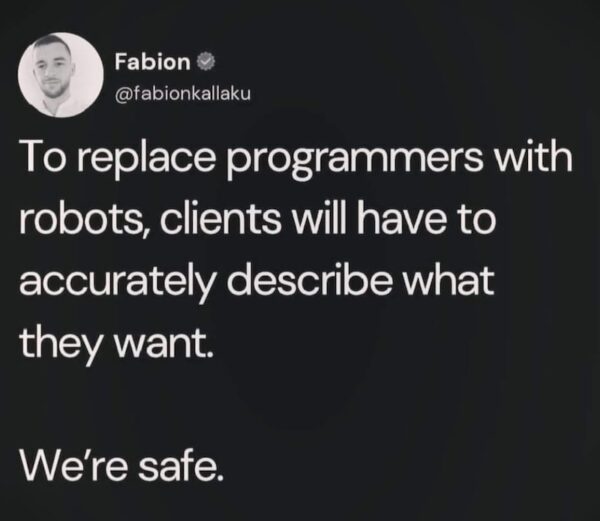Category: Artificial Intelligence
Want to learn a lot about Python, whether you’re brand new to the language, or a long-timer? Humble Bundle’s The Complete Learn to Code Python and ML Megabundle might be just what you’re looking for, costs only US$25 for the full set, and is available for another 7 days (at the time of writing — 1:40 p.m. on Monday, October 28, 2024)!
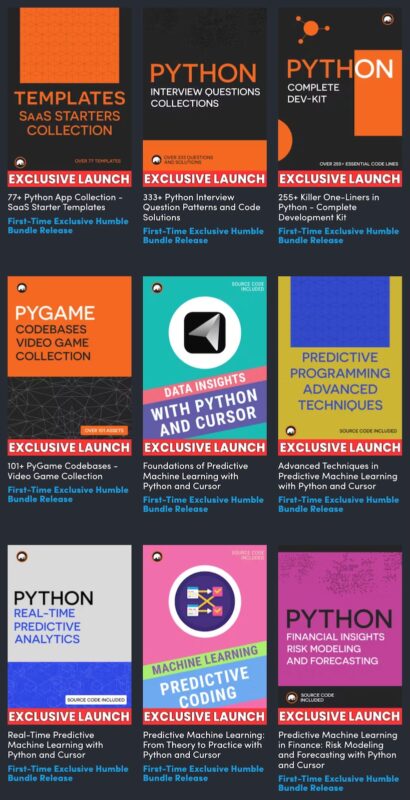 $25 gets you 45 items, all of which are pictured in this post. Some of these items are complete tutorials, while others are simply collections of sample code. I decided to YOLO and simply buy the whole thing.
$25 gets you 45 items, all of which are pictured in this post. Some of these items are complete tutorials, while others are simply collections of sample code. I decided to YOLO and simply buy the whole thing.
I’m going to sift through the offerings and write about them over the week here. Watch this blog!
A portion of the proceeds from sales of the megabundle will go towards Children’s Miracle Network Hospitals, so you’ll be getting some useful Python info and helping a good cause at the same time.
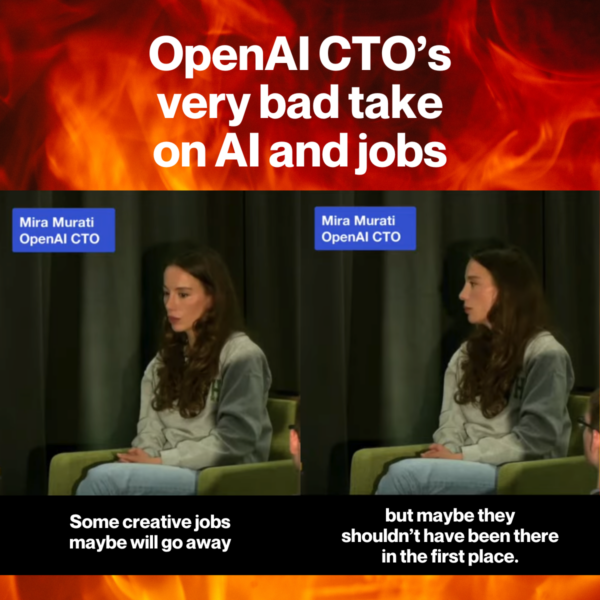
Some techies hold the attitude that “what I do is important, and what you do isn’t,” and the more socially savvy ones don’t say the quiet part out loud.
But Mira Murati, OpenAI’s CTO, did just that onstage at her alma mater, Dartmouth University, where she said this about AI displacing jobs in creative lines of work:
Some creative jobs maybe will go away, but maybe they shouldn’t have been there in the first place.
Mira Murati, from AI Everywhere: Transforming Our World, Empowering Humanity
(she says this around the 29:30 mark)
Here’s my take on her bad take, courtesy of the Global Nerdy YouTube channel, which you should subscribe to…
…and here’s the video with her full talk at Dartmouth:
Her

where OpenAI CEO Sam Altman is in the Canva-ized picture above.
Tap to view at full size.
If you’re a regular reader of this blog, you’ve probably seen (or at least heard about) the demo of GPT-4o’s voice assistant mode featuring a voice named “Sky” providing vivacious — even flirty — assistance:
When I saw it, my first thought was “Wow, that’s a lot like Scarlett Johansson’s portrayal of the AI in Her,” and that seemed to be a lot of other people’s first thoughts.
This belief is backed by the publicly-known fact that Her is OpenAI CEO Sam Altman’s favorite movie, a fact he announced less than a year ago in front of the audience of Salesforce’s Dreamforce 2023 conference:
“I like Her. The things Her got right—like the whole interaction models of how people use AI—that was incredibly prophetic.”
San Fransisco Standard, September 12, 2023.
There’s also Altman’s single-word post on X/Twitter, which he posted on the day of the GPT-4o’s premiere on Monday, May 13th:
And now, we find out that Scarlett Johansson — the “Her” herself — issued a statement on Monday, May 20th saying that she was approached by Sam Altman to be the voice of this version of GPT, and that she turned down the offer.
Here’s the text of the statement:
Last September, I received an offer from Sam Altman, who wanted to hire me to voice the current ChatGPT 4.0 system. He told me that he felt that by my voicing the system, I could bridge the gap between tech companies and creatives and help consumers to feel comfortable with the seismic shift concerning humans and A.I. He said he felt that my voice would be comforting to people. After much consideration and for personal reasons, I declined the offer. Nine months later, my friends, family and the general public all noted how much the newest system named ‘Sky’ sounded like me.
When I heard the released demo, I was shocked, angered and in disbelief that Mr. Altman would pursue a voice that sounded so eerily similar to mine that my closest friends and news outlets could not tell the difference. Mr. Altman even insinuated that the similarity was intentional, tweeting a single word, ‘her’ — a reference to the film in which I voiced a chat system, Samantha, who forms an intimate relationship with a human.
Two days before the ChatGPT 4.0 demo was released, Mr. Altman contacted my agent, asking me to reconsider. Before we could connect, the system was out there. As a result of their actions, I was forced to hire legal counsel, who wrote two letters to Mr. Altman and OpenAI, setting out what they had done and asking them to detail the exact process by which they created the ‘Sky’ voice. Consequently, OpenAI reluctantly agreed to take down the ‘Sky’ voice.
In a time when we are all grappling with deepfakes and the protection of our own likeness, our own work, our own identities, I believe these are questions that deserve absolute clarity. I look forward to resolution in the form of transparency and the passage of appropriate legislation to help ensure that individual rights are protected.
New York Times, May 20, 2024
“OpenAI’s gonna OpenAI,” as this soon-to-be-common phrase goes, and they’ve been making their trademark obfuscating statements. As Ed Zitron summarizes in an article titled Sam Altman is Full of Shit:
Just so we are abundantly, painfully, earnestly clear here, OpenAI lied to the media multiple times.
Sam Altman Is Full Of Shit, Ed Zitron, May 21, 2024
- Mira Murati, OpenAI’s CTO, lied to Kylie Robison of The Verge when she said that “Sky” wasn’t meant to sound like Scarlett Johansson.
- OpenAI lied repeatedly about the reasons and terms under which “Sky” was retired, both by stating that it “believed that AI voices should not deliberately mimic a celebrity’s distinct voice” and — by omission — stating that it had been “in conversations” with representatives to bring Johansson’s voice to ChatGPT, knowing full well that she had declined twice previously and that OpenAI’s legal counsel were actively engaging with Johansson’s.
If you haven’t seen the movie Her, you’re probably wondering where you can find it on a streaming service. Here’s where you can watch it right now if you’re based in the U.S. (where I’m based):
And if you need a little more temptation to watch the film, here are its two official trailers:
